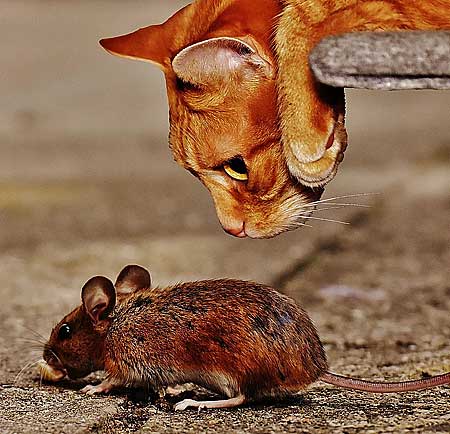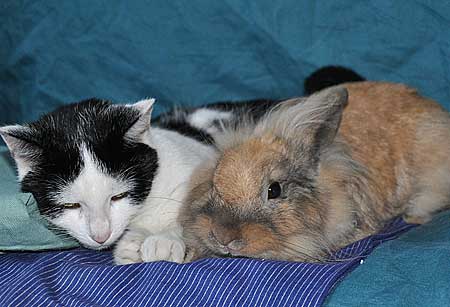How to Live In Peace with Your Cat and Small Pets?

How To Live In Peace With Your Cat And Small Pets?
Having a cat as a pet is like having your own little child. Taking care of it is a difficult task in itself. Despite the responsibilities it brings, there is absolute fun and satisfaction in looking after a cat.
In the cat parenting world, there exists the stereotype that feline pets are hateful towards other pets, including their own kind. As such, cat parents think that it is difficult to provide their homes to other pets. However, this is just a false assumption.
A multi-species household may be a challenge, but it is possible. With domestication, proper training, and a huge chunk of patience, you will have a harmonious life with your feline baby and other small pets.
Nature of Cats
In the wild, cats survive as natural predators. Their nutritional sustenance lies on their ability to hunt their prey. This natural predatory instinct is found even in domesticated cats.
Domesticated cats do not really have to hunt for their survival since their needs are mostly provided by their caregiver. However, their natural instinct to kill their prey still courses through their veins. So, if you already have a cat, this is something that you should keep in mind if you want another pet.
Keeping a cat and another pet in one home is placing a natural predator and its prey in one location. The cat has to be rigorously trained to stave off its hunting instinct. If you are not confident that you can successfully protect both the cat and the new pet, then, re-think about your decision.
In maintaining a peaceful multi-species household, the first step you will have to take is to carefully choose the species to introduce to your feline baby. While a larger pet might scare your cat, a smaller one will give your cat a feeling of dominance. Thus, your decision on what small pet to add to your family has to be a wise and informed one.

Small Pets
When thinking of a small pet to the house with your cat, the first thing that comes to your mind is a rodents. Mice and hamsters, which are smaller than cats, tend to always run away from a feline. Fancy rats are bigger and bolder.
Another choice that you have is to take care of a bird. Take note that birds are easily intimidated by the stare of onlookers. Small birds such as a parakeet are at risk of chronic intimidation and even of injury or death.
If your heart is set on reptiles, then, housing them alone is the better choice. Never trust a snake or a monitor lizard with your cat. In this situation, your cat is in danger of becoming the prey.
Of course, you can also take care of any fish species. In deciding for a cat and a fish at home, the safety of the fish tank is the key.
In choosing what small pet to combine with your cat, consider what their relationship is in the wild. Generally, however, for smaller pets, the relationship will be that of a hunter and prey. Adding a small pet, except for snakes and other reptiles, will surely take your patience in taming down your feline.
Wherever you want to get your new pet from, always ask about how it was raised by its previous caretaker. This will give you a jumpstart on how to handle the pet and your cat.
Also, ask about the pet’s experience regarding prior interspecies interaction.

Introduction of the New Pet to the Cat
The first and most crucial step in nurturing a multi-species household is the introduction of your cat to your new pet and vice versa. It has to be done slowly and might even last for months. They cannot be made to face each other during the first time that they meet.
There are two manners of introduction that you can do: olfactory and visual. If one fails, then do the other one.
The olfactory introduction is all about scent familiarization. Through scent familiarization, your feline baby will become less aggressive and less territorial.
The first method that you can try is to rub a washcloth on your new pet and then leave it with your cat and vice versa. You may also opt to exchange the blankets of the pets.
Another method that you can try is to feed them on each side of the door. Through this, they are forced to eat nearby each other. Although they cannot see one another eye to eye, the scent will get through the door.
If the new pet is a rodent, then, just place the cage closer to the door. Do not allow the rodent to roam free. Their small body can easily slip through the door crack.
Also, even without taking extra steps to introduce the scent of the new pet to your cat, they are able to know if there is a new member of the family. Always make sure that the new pet is in a secure room or is caged.
For purposes of safety, only do the visual introduction once they are already familiar with each other’s scents. This is to minimize the tendency of animosity between them.
You can make your cat take a peek on the new pet, and vice versa. In doing so, the door shall only be opened at an inch. Do not make the mistake of opening the door too widely since this will increase the possibility of aggression.
If you feel like they are ready to finally meet each other, do so in a neutral room like the bathroom. Through this, feelings of territoriality will not be ignited.
During the first few weeks, it is encouraged that they are always under supervision when interacting. The goal is to make the kitten lose interest on the other pet, as instructed by PurringPal.
Monitoring
A successful introduction does not equal to a long-lasting harmony between your cat and your new pet. Listed below are guidelines on what you have to observe in supervising the relationship between the two.
Never leave them alone. If you would do so, ensure that the smaller pet is caged. Cages are important for the safety of both the cat and the new pet.
Make sure that the bars of the cage are close together, thus, impassable for both of them. Also, always check if the bars are made of a material that cannot be chewed by the cat. Secure the cage in a spot that cannot be knocked down or over by the cat.
If the smaller pet is a fish, do not take the risk of using a fishbowl. A fishbowl can be easily accessed by your feline baby. Instead, use a fish tank.
Give your cat plenty of attention and distraction in the form of toys (not depicting the small pet).
Toys and food will reduce their anxiety. In picking a toy, make sure that it does not depict the small pet. For instance, if your pet is a rabbit, do not give your cat a stuffed rabbit. This is to not make them think that it is okay to bite or do whatever to the other pet.
Offer treats when they are together.
During fights, take them to their separate rooms. Then, slowly introduce them to each other again.
If the cat is still aggressive after doing all possible efforts, take the feline to a veterinarian to check for behavioral problems.
Invest in a squirt bottle. This is the most effective way to control the cat’s behavior. Fill the bottle with water only.
Another alternative is to make a loud noise by banging a pan. You can also throw a pillow to break up their fights.
Secure a safe spot for both the cat and the new pet.
Conclusion
Before living a peaceful life with your cat and your new pet, you would have to undergo a lengthy process. The most essential ingredient is your patience. The process will be slow and tiring, but at the same time, it is also very rewarding.
Arm yourself with the needed patience and you would be able to savor the pleasure in having a cat and another pet within your household.
